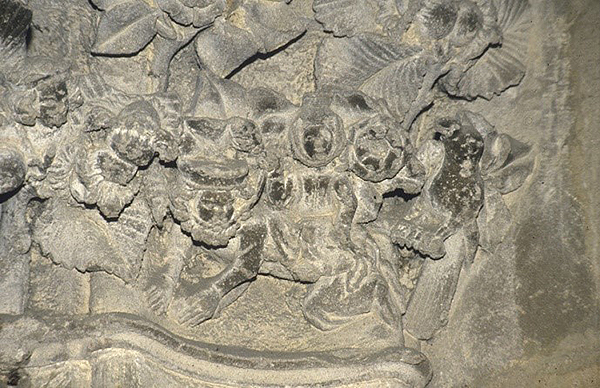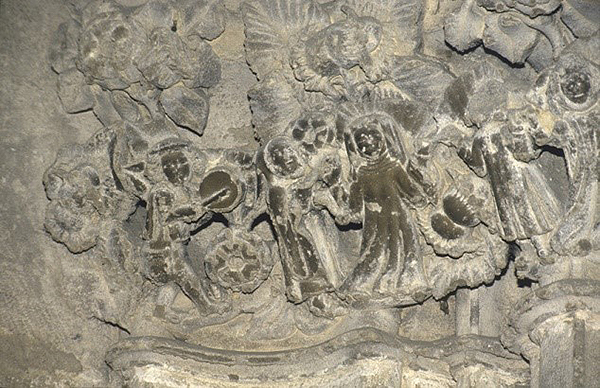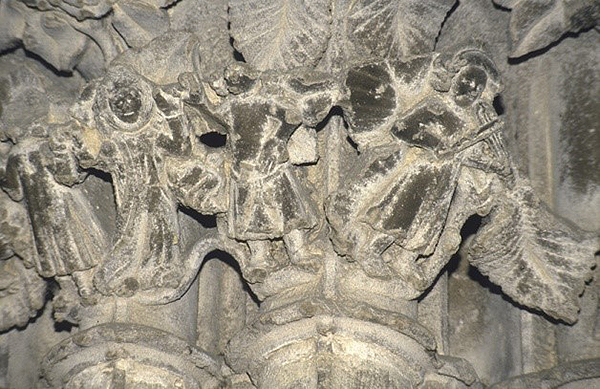20 May
lecture series
LESSER-KNOWN IMAGES OF NAVARRESE MEDIEVAL ART
Profane scenes and sacred spaces: a little-known reality of medieval art
Ms Miren Eukene Martínez de Lagos Fernández
University of the Basque Country
Traditionally, profane iconography has been relegated to a "marginal" status compared to the religious programmes that are displayed on the doorways, apses or walls of cathedrals, cloisters or parish churches and occupies a secondary place, inherited from the Romanesque, with some exceptions. Moreover, the analysis and study of this aspect of iconography is complex: firstly because of the great variety of different themes it encompasses and secondly because of the disparity of visual and written sources to be considered. However, this complexity also makes profane iconography an extremely attractive field in which much remains to be done.
It is in monumental decoration where profane themes share space with sacred themes and appear in perfect communion with motifs inspired by the Holy Scriptures, stories or hagiographic texts, so that the study of the possible intentionality of these images should consider both aspects of iconography. As Professor Yarza has already pointed out, profane themes sometimes act as a counterpoint or develop a parallel world to the religious one, i.e. they not only share space, but may also share something else: a didactic and moralising intention, a satirical and burlesque content, or perhaps also a testimony that those responsible, the mentors of that work, were fully up to date and aware of the latest stylistic novelties and the newest iconographic repertoires. Because it was these new repertoires, together with those that came from the heritage of Antiquity, clearly legitimised by tradition, that gave immediate figurative prestige to the architectural work that was being monumentalised, and this increased its transcendence.
What there is no doubt about is that these profane images are testimony to the way of life and the way of thinking and feeling of a society in which the boundary between the sacred and the profane was very blurred and both spheres were linked and intermingled. For this reason, and although on some occasions a certain attitude of counterpoint to the religious world can be glimpsed, on the majority of occasions they are a complementary and enriching reality, which gives us sample an endless amount of knowledge and beliefs that circulated in the environment and which were captured through images that were highly illustrative and accessible in their function and significance for the society that created them.
In this sense, the cloister of Pamplona Cathedral is no exception; other Hispanic Gothic cloisters such as León, Burgos, Oviedo, Barcelona and Santes Creus have both sacred and profane themes in the decoration of their capitals and corbels. This was already evident in the Romanesque cloisters. Many of the profane and fabulous themes found in the Romanesque cloisters would continue to be present in Gothic Art, Pamplona being an example of this, but others were also incorporated, because this new secular and profane culture was already making unstoppable progress. In the late medieval centuries there was an increasingly marked irruption of profane values and therefore the artistic representations of these new concerns gradually conquered more significant places in the decoration of religious buildings.
In the case of Pamplona, the sculptural decoration of the cloister capitals is mainly profane. There are only seven capitals with religious themes and they are located on the east side, while those with profane figures are much more numerous, with a great variety of themes and spread not only along this same side, but also along the north side. Their chronology belongs to the first phase of the cloister works, between 1280 and 1318 approximately, and they cover musical activities, hunting, bullfighting, daily work and chores, sports or shows of the time and courtly celebrations, without forgetting that some of these profane repertoires will have a singular influence on the monumental decoration of other churches or parishes in the surrounding area, such as Zizur Mayor or Ujué, to mention just two examples.
This lecture will focus on a series of figurative motifs that show that at the end of the 13th century and in Pamplona one of the most important Gothic cloisters in the peninsula was built, a cloister that incorporates the forms of the radiant Gothic that emerged in the North of France and which also presents a sculptural decoration that speaks of the existence of a mentor of broad culture, both sacred and profane, which was fully up to date and knew the most avant-garde figurative repertoires of the time.
I am going to focus on a specific capital, a capital that presents four different scenes and is located on the perimeter wall of the east wall. It belongs to the first phase of the work on the cloister and illustrates the history of the Lai of Aristotle.
The Aristotle's Lai is a didactic and satirical story about the Greek sage and philosopher. framework The story, which is a fantastic tale, is based on the Eastern campaigns of Alexander the Great, who falls madly in love with a beautiful Indian courtesan or princess, depending on the version. However, this is not the only representation of this capital, because just on the other side we can see an open choral dance, identified with a carola, and in the central area of the capital, a representation related to the codes of Courtly Love. I have always thought that these three scenes formed a unitary thematic ensemble with a global meaning, as the visual testimonies that recreate the attitudes and behaviour of this cultural model bear witness to this. They all form part of the usual repertoires linked to this new profane and chivalric culture that was to develop from the literary creations of the poets and troubadours of the 12th century.

Lai of Aristotle. Capital of the Cloister of Pamplona


Medieval carola. Capital of the Cloister of Pamplona

Loves of Alexander and the beautiful Indian. Capital of the Cloister of Pamplona
